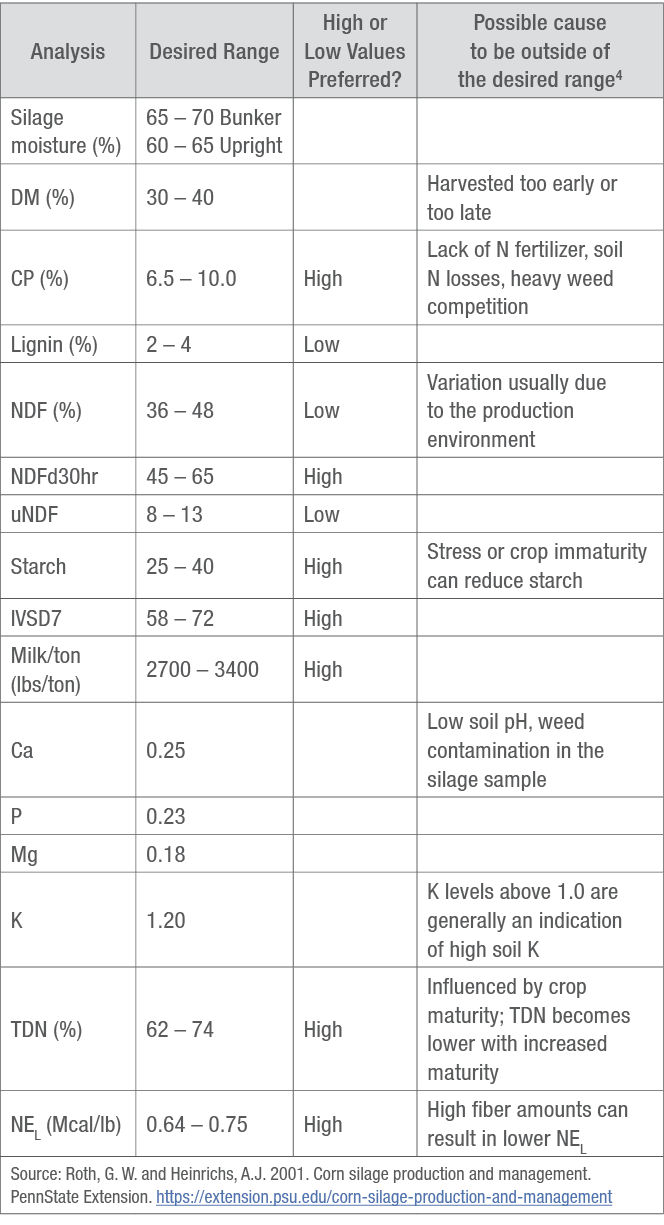Parameters for Silage Product Selection
January 11, 2024
Introduction
- Selecting a product for silage is a decision about feed and cow performance.
- There are several variables to consider for selecting a product for silage including product maturity, agronomic reasons (plant height, standability, disease resistance, etc), quality, quantity, and flexibility.
Maturity
Silage yield increases with longer relative maturity (RM) corn products because plants have more time to accumulate additional dry matter in the form of grain and stalks, adding to yield potential. Consider silage products with RM ratings 5 to 10 days longer than corn products intended for grain.1
Agronomic Reasons
Silage acres were once a risk protection for marginal ground but are now an intentional choice for feed. The local growing conditions should be considered, and products selected with the appropriate basic agronomic traits such as emergence, heat, stress or drought tolerance, response to high populations, etc. Corn products that perform well over a variety of environments, year after year, are ideal since annual weather patterns cannot be predicted.
Feed Quality
Fiber level is a key reason to use silage as a feedstock. Dry matter intake leads to milk production by cows. The balance between fiber amount and digestibility affects dry matter intake. Generally, corn products can be selected based on yield potential, fiber content and digestibility, land availability, and supplementation cost.
- When supplementation cost is low and land base is limited, a silage with greater fiber is desired for cow feed.
- When supplementation cost is high and land base is not limited, a silage with lower fiber is desired for cow feed.2
Table 1. Summary of silage sample laboratory analyses, desired range of values, and possible causes of a value being outside of the desired range.

Silage Yield
Grain yield is one of the best indicators of silage yield.1 Silage yield goals begin with feed requirements for the cattle operation. Some quick calculations help growers select corn products for available acreage.
- Know corn silage feed requirement (ex. 4,000 tons)
- Gather enough data from different environments to estimate corn product yields (ex. 30 tons/acre)
- Calculate how many harvested acres are needed with selected corn products to meet feed requirements (ex. 133.3 acres at 30 tons/acre needed to meet feed requirements)
If feed requirements are met and acres remain for harvest, the extra acres can be taken later for grain harvest.3 Having a variety of corn maturities in the corn product portfolio allows for flexibility when deciding between grain or silage harvest at the end of the season.

Other important contributing factors to silage yield include soil fertility, plant height, canopy, and plant population. Fertilizer needs for planned silage acres may be different compared to corn that is being grown for grain production. Optimal plant populations to maintain digestibility and quality would be corn product specific. Consider local yield trials as good indicators of performance and compare base yield on the same dry matter (DM) basis (typically either 30% or 35% DM).2,4
Flexibility
When unsure whether fields will be used for silage or grain harvest, growers should seek out a dual-purpose corn product. Dual-purpose corn products should have high grain and forage yield potential. Begin by finding a portfolio of corn products adapted to the area for maturity, disease, and drought tolerance. If dual-purpose corn products are unavailable, consider expanding the range of maturities to allow for a wider harvest window and the possibility of using extra acres after silage needs are fulfilled for grain. Additionally, several maturities in the harvest window range helps improve the chance of harvesting at the proper moisture content, a key factor in silage quality and storage.
Sources:
1 2023. Hybrid selection. Corn Agronomy. University of Wisconsin - Madison. http://corn.agronomy.wisc.edu/Silage/S001.aspx
2 Durst. P. 2021. Selecting corn hybrids for silage based on quality measures. Michigan State University. https://www.canr.msu.edu/news/selecting-corn-hybrids-for-silage-based-on-quality-measures.
3 Coulter, J. 2021. Selecting corn hybrids for silage production. University of Minnesota Extension. https://extension.umn.edu/corn-hybrid-selection/selecting-corn-hybrids-silage-production.
4 Roth, G. W. and Heinrichs, A.J. 2001. Corn silage production and management. PennState Extension. https://extension.psu.edu/corn-silage-production-and-management.
Websites verified 12/20/23 1227_324929
Seed Brands & Traits
Crop Protection
Disclaimer
Always read and follow pesticide label directions, insect resistance management requirements (where applicable), and grain marketing and all other stewardship practices.
©2024 Bayer Group. All rights reserved.